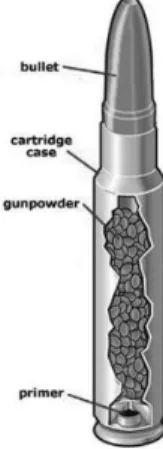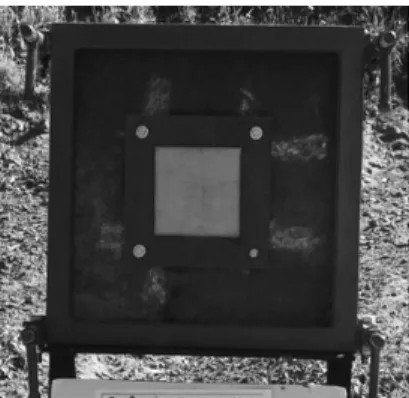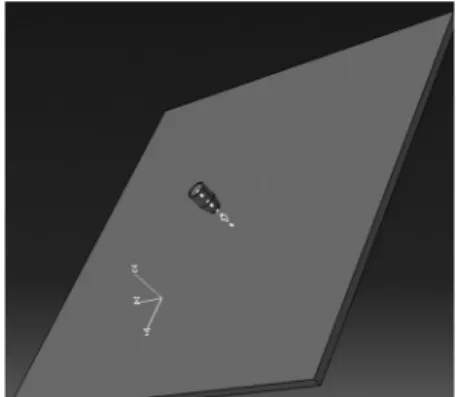Numerical aNd experimeNtal aNalysis of Ballistic armors
José Mestre a, João Ferreira a, Luís Pina b, José Borges a1
a CINAMIL - Centro de Investigação da Academia Militar, Academia Militar, Lisboa, Portugal
b INEGI - Instituto de Ciência e Inovação em Engenharia Mecânica e Engenharia Industrial, Porto, Portugal
ABSTRACT
The scientific and technological development of armors is always trying to match the constant improvement of weapons and their piercing power, many of these are developed for specific purposes to increase their ability to protect people and equipment. To achieve this objective, it is often ne-cessary to use innovative solutions, in terms of the materials used in the manufacture and in the type of the armor itself.
This dissertation intends to take the first steps in the production and tes-ting of ballistic protection materials in real shootes-ting situation, as well as modeling and simulation of the same with the purpose of acquiring skills, techniques and procedures for future work.
The theoretical work of this thesis focused on the development of a biblio-graphic study on the subject, explaining ballistic elements, their evalua-tion, models of analysis, the explanation of some concepts related to the phenomenon of impact, the characteristics of composite materials and the description of its production process.
The experimental work was performed in the shooting range of the Escola das Armas where targets were tested with the produced composite materials and aluminum plates, with different combinations.
Modeling and simulation of ballistic elements was performed in order to compare the simulation results with the results of the experimental work. The results obtained from the simulations were acceptable compared to the experimental ones, taking into account that for the comparison purposed it is intended to evaluate in a qualitative manner: the total perforation, partial perforation or non-perforation.
Keywords: Armor, Composite materials, Shooting range, Numerical simu-lations, Ballistic elements, Perforation.
1 – INTRODUCTION
The use of shields is extremely important in the current scenario of modern warfare. In operational context, soldier protection is fundamental to allow its physical integrity in order to continue his duties and it is also important to understand the level of ballistic protection under the different threats to which it is subject.
The current technical/scientific development around the ballistic protection has thought to match the constant improvement of the projectiles and their penetrating power (Pinto, 2009).
Ballistic protections began to incorporate various kinds of materials, where each one performs a specific function inside the assembly. The new types of protection are made of composite materials because they possess high strength and/or stiffness relative their weight, and good damage tolerance (Nayak et al., 2013; Zhang et al., 2014).
The fibers commonly used for ballistic protection are aramids and very high molecular weight polyethylene that can be combined with a wide variety of resins. To date, the protections made with only polymeric composite materials have proved ineffective against piercing projectiles. For this type of projectiles it is needed to add a ceramic plate, being the most used ma-terials based on alumina, silicon carbide and boron.
The ceramic element due to its high hardness minimizes the penetration power of the projectile and breaks its tip/core, while the polymeric composite material supports the ceramic element and captures the fragments (Bürger et al., 2012; Tasdermici et al.,2012).
The technology is constantly envolving, for each new offensive develop-ment, a matching defensive solution must be pursued. For a fastest bullet, a tougher vest (Monteiro, 2007).
1.1 Ballistic elemeNts
Ballistic elements are ammunition and ballistic protection elements. A new application of ballistic panels began to be studied and developed in this paper for individual ballistic protection.
Protection of this type include mainly the vests and helmets.
The science that deals with the study of these elements is Ballistics, which studies the forces acting on projectile and its movments from its initial position within the weapons to their penetration of the targets that are ai-med at. The field of Ballistics can be classified into three broad categories: internal ballistics, external ballistics and terminal ballistics.
1.2 Ammunition of Small Arms
The ammunition of small arms is the set of the projectile and means to bring about its propulsion, which are composed of four key parts:
Figure 1 - Ammunition of small arms
(Pereira, 2010).
1.3 Ballistic protectioN elemeNts
Within the ballistic protection elements it must noticed that there are rules defining ballistic protection levels by setting the corresponding ballistic resistance capacity.
Ballistic vests are intended to protect people from impacts with high kine-tic energy. Despite its employment does not guarantee 100% security, the ballistic vest ensures a significant reduction of the probability of the wearer to be fatally injured of suffer to internal organs damage, but may leave him temporarily unable to react the threats.
The base material of the bullet-proof jackets are modern ballistic fibers like, aramid, which provide a high degree of resistance as well as flexibility and comfort. The aramid consists of a compound formed by high strength and light weight fibers, to which are added special resins.
The tactical plates consist of an additional armored protection, composed of rigid materials that are sometimes joined together, to increase the ballistic protection level of the vest.
In what regards the materials used, they range from cooked aramid fabrics and high density polyethylene enamel settings, ceramic or steel.
As stated above, the ballistic protection elements follow rules governing ballistic protection levels. In the case of ballistic vests, these must be de-veloped to meet standards and specifications that ensures performance and the desired ballistic resistance.
The ballistic vests follow the norm of the American National Institute of Justice (NIJ) named “Ballistic Resistance of Body Armor NIJ Standard – 0101,06”, being the standard used by manufacturers of ballistic vests. Ballistic helmets are designed to protect the warfighter against injury cau-sed by ballistic projectiles from firearms, as well as shrapnel, reaching the ballistic protection level III (NIJ).
1.4 evaluatioN of Ballistic protectioN elemeNts
The performance assessment procedures for ballistic protection elements must be implemented in accordance with the following standards:
- Allied Engineering Publication (AEP) – 2920; STANAG 4569; NIJ Standard – 0101,06.
The following table shows the ballistic protection levels according to the NIJ Standard – 0101,06
Table 1 - Ballistic Protection Levels NIJ
Standard -0101,06
For an impact to be considered valid, it shall occur at a distance greater than 30 mm of any support or attachment point, prior impact, deformation or disturbance of the material.
Ideally, the layout of the test facility for ballistic protection elements must consist of: a gun (or ballistic cannon); detection system for measuring ve-locities of projectiles, fastening system of the panels to be tested, witness plate, and the projectile.
Before any ballistic test, all the test facility must be inspected and all pa-nels should be inspected visually to verify that there is no damage during transportation. If damages are observed, the test shall not be executed with those panels, it must be registered as defective.
All targets should provide the following information: the serial number, the category of the target, type of ammunition to be used and identification of the entrance and exit surface of the target.
2 – MODELLING BALLISTIC ARMORS
The most commonly used models have been classified into three categories: Empirical – models resulting from the observation of a large number of experimental observations.
Analytically – models resulting from the introduction of simplifying as-sumptions that enable the expression of the relevant phenomena by diffe-rential equations.
Numerical – models obtained by applying techniques of finite elements or finite differences, and allow the solution of the equilibrium equations of the continuum.
2.1 coNcepts related to impact pheNomeNa
There are three fundamental principles that are on the basis of impact phe-nomena, the conservation of mass, conservation of momentum and energy conservation.
For a correct description of the impact process it is necessary to use an equation of state (EOS), which relates the thermodynamic properties (pressure and internal energy) of a material with its density and temperature. During a ballistic impact, the pressures involved are very high, often higher than the resistance of the material. When this happens it is convenient to use an EOS. The compressibility effects (density change) and the irreversible ther-modynamic processes such as heating due to shock are considered by EOS. Impact designations like low speed or high speed require limits to be set that make this a more objective terminology.
Low speed Impact: v < 250 m/s
Average speed impact: 250 m/s < v < 0,5 km/s High speed impact: 0,5km/s < v <2 km/s Hypervelocity impact: v > 2 km/s.
At low speed impacts are associated with actions and reactions of the or-der of milliseconds and penetrations or contact deformation fundamentally determined by the global behavior of the structure.
In the speed range of 0,5 to 2 km/s, the response of the structure, globally, has little relevance in the study of the behavior of the region suffering the impact. The impact will then be treated as a wave propagation phenomenon
wherein the deformation speed aspects, flow geometry and plastic failure modes must be taken into account in the modeling process.
In the speed range 2 to 3 km/s, would cause local pressure to rise several times higher than the resistances of materials and is a typical behavior of fluids For very high speeds over 12 km/s, vaporization of materials occurs (Zukas, 1982). 2.2 Shockwaves
With regard to dynamic events at high speeds, the shockwaves are present and can be defined as a mechanical wave of finite amplitude, being initiated when the material is subjected to a quick compression. A forced motion in a deformable medium creates these waves, often called the disturbance. This medium is modelled trough material points that are forced to become dis-placed from their equilibrium position due to the disturbance that propagates through the material. This propagation transmits amounts of energy point to point within the material in the form of kinetic and potential energy, mecha-nical wave may be characterized by energy transmission through oscillatory movements between points of the material, about an equilibrium position. However, the medium offers resistance to the movement and eventually this will decrease until a state of static strain achieved due to friction loss and broadcast waves (Lama, 2013).
Figure 3 - Particle motion about its equilibrium condition (Lama, 2013)
3 – BALLISTIC TESTS
Ballistic tests were conducted in the shooting range at Escola das Armas, Mafra. The targets were aluminum plates (alloy 6061-T6) and composite materials. These latter were produced at INEGI (Faculdade de Engenharia da Universidade do Porto), being composed of 24 layers of Kevlar and fiberglass and 4 layers of carbon coated with epoxy resin. For testing, 10 composite panels and 4 of aluminum were used.
The threats selected for the tests were walther pistol and automatic rifle G3, corresponding to level II and III threats in accordance with NIJ Standard-0101.06. A test plan considering the amount of materials available, was prepared, al-ways assuming that there would alal-ways be full penetration. However, in the course of the ballistic tests, the testing plan was changed to maximize the number of test carried out, since there was not full penetration in all panels. testiNg plaN accomplished
The tests executed with the Walther pistol was executed shot from a dis-tance of 10 meters:
Table 2 - Ballistic tests made with walther pistol.
4 test were executed with the G3 automatic rifle:
The first 3 tests were made from a distance of 50 meters while the last one was made from a distance of 100 meters.
3.2 requiremeNts of Ballistic paNels
A ballistic panel should be able to stop the projectile. The panels under study also have to fulfill other requirements, taking into account that a future application may be for personal protection, following:
• Protection against the defined threat;
• Cause minimal constraint on the operational functions performed by the Soldier; • Low weight;
• Be under the maximum weight defined by the Standard NIJ according to the ballistic resistance.
3.3 coNstructioN of metallic adapter
An existing support equipment was used in, which had already been used to test other materials, however, this support only allows 0.5x0.5m panels. As the support dimensions were too large and taking into account the panels to be tested had reduced dimensions, it was necessary to build a metal adapter.
Figure 4 - Metallic Adapter.
3.4 test results
When using the G3 automatic rifle, the ballistic protection panels were inefficient, since they were completely penetrated by the projectile.
However, when using the Walther pistol and 2 composite panels as targets or 1 composite panel and 1 aluminum panels together, the results were acceptable because the projectile just perforated the front panel stopping before making relevant damage to the second panel.
The results when targets assured ballistic protection are presented in the following figures.
The first panel which suffered partial perforation by the projectile, when two composite panels were used, is presented in figure 5.
Front Side Back Side
Figure 5 - First Composite panel.
The damage caused by the projectile on composite panel and on the front side of the aluminum panel are presented in figure 6.
Front Side Back Side Front side (Aluminum Panel)
Figure 6 - Ballistic test, targets: 1 composite panel and 1 aluminum panel.
4 – NUMERICAL SIMULATIONS
The simulations were performed using the finite elements method in the Abaqus software, these were done only with the 9mm bullet because it
pro-vided the greatest diversity of results in terms of perforation, the selected trials for computational simulations were:
• 1 Composite Panel; • 2 Composite Panels; • 1 Aluminum Panel;
• 1 Composite and 1 Aluminum Panel.
Regarding the projectile materials, the study conducted by the Polícia Ju-diciária showed the ammunition 9mm parabellum, as follows:
• Jacket: thickness (650 microns), 95% copper and 5% Zinc ; • Core: 100% Lead.
In relation to the target (Aluminum and Composite Panels) it was used an Aluminum alloy 6061-T6, while the composites are constituted by an epoxy matrix and Kevlar®, carbon and glass fibers.
One of the great difficulties of this work was to find the properties of the involved materials in the literature, to feed the constitutive models of the materials in the software.
For metallic materials, the Johnson-Cook model in Abaqus software con-siders both plasticity and fracture phenomena. So, a search was conducted to find the materials properties required for this model.
For composite materials, the model implemented in Abaqus is focused on their response to damage, the Hashin damage model. A search was also conducted to find the material property values that this model needs. The complexity of the dynamical simulations caused the software to recur-rently abort the analysis due to numerical instability. Proper simulations could only be obtained for the Aluminum target. For the composite targets a rigid body projectile had to be used to stabilize the numerical analysis, where only the shape, speed and mass of the projectile had to be defined. A sensitivity analysis was performed on the residual velocity of the pro-jectile perforating the Aluminum target to evaluate the reasonability of the rigid body approximation.
4.1 developed models
In Abaqus software, one has to define the target and projectile geometries, along with the relevant material properties. Then, the interactions between the projectile and the target have to be established, along with the loads
and boundary conditions. The initial speed of the projectile was set to 400 m/s. Finally, the involved elements had to be meshed.
Figure 7 - Assembly: projectile and target.
4.2 approximatioNs
The finite element method is an approximate analysis and problem solving tool. In these simulations the following approaches had to be considered: • Friction effects were not considered;
• The projectile was considered a rigid body due to numerical instability reasons, • Delamination of composite materials was not considered because it was not available in the software. A user defined subroutine needs to be implemented, • Composite materials were not characterized by EOS as they were modeled
as shell elements;
• For composite Kevlar/Epoxy the same dissipation energies of carbon/epoxy were considered since it was not possible to find the relevant property values in the literature.
• It was not considered fiberglass layers because it was not possible to find the relevant property values.
4.1 simulatioN results
The simulation in which the target was only aluminum, with both deforma-ble and rigid projectile, more deformation of the target was obtained with the deformable projectile. However, the results of both simulations was the same: full penetration.
With the sensitivity analysis to the residual velocity of the projectile, a difference around 50m/s, with the hard projectile to take a higher residual velocity with the value of 293 m/s.
For composites the result was also acceptable in comparison with the experi-mental results, i.e. a single composite panel was completely perforated, while in the second composite panel prevents the projectile from passing through them. In the latter situation (Aluminum and Composite Panels), the projectile does not completely perforate the target. However, elements were eliminated from the aluminum mesh, that was not observed in the real fire experiment which only shows a slight deformation.
As shown above for the experimental results, the following figures show case of two composite panels and one composite panel followed by one aluminum panel. Both figures show the last step of the simulation.
Front Side Back Side
Figure 9 – Target: 1 Composite Panel and 1 Aluminum Panel.
5 – CONCLUSIONS
From obtained results, it was found that a single composite panel cannot provide sufficient ballistic protection in the face of the Walther pistol threat, being completely pierced by the projectile. However, when a second composite or aluminum panel were added the obtained results, showed no perforation nor deformation of the added panel.
When it comes to shielding for individual protection, weight is a key feature and in these cases, the weight was 31,25kg/m² and 33,25kg/m² respectively, which is above the limit 25kg/m2 according to the established standards. The comparison between the experimental and simulation results showed similarities in terms of perforation, despite the applied approximations. These approximations had to be made to arrive at stable numerical results, both in terms of the composite material models and the properties of these materials that could not be obtained by laboratorial measurements and ty-pical values found in the literature had to be used.
6 – REFERENCES
Bürger, D.; Rocha de Faria, A.; de Almeida, S.F.M.; de Melo, F.C.L., Donadon, M.V.; Ballistic impact simulation of an armour-piercing projectile on hybrid ceramic/fiber reinforced composite armours, International Journal of Impact Engineering 43, 63-77, 2012.
Lama, J. G., Metodologia de Análise Aplicada a Ensaios de Impacto com Alvos Metálicos, Universidade Estatual Paulista “Júlio de Mesquita Filho”, Guaratinguetá, 2013
Pereira, N., Os Calibres das Armas Ligeiras de Infantaria – Potencialidades e adequabilidade dos calibres 7,62 NATO e 5,56 NATO às missões contemporâneas, Academia Militar, 2010.
Pinto, J.M.G.T., Avaliação do Comportamento Mecânico de Blindagens Balísticas, Engenharia Mecânica, Instituto Superior Técnico - Universidade Técnica de Lisboa, 2009.
Monteiro, P., Avaliação do Desempenho de Blindagens na Proteção de Pessoas e Equipamentos, Instituto Superior Técnico, 2007.
Nayak, N.; Banerjee, A.; Sivaraman, P., Ballistic Impact Response of Ceramic-Faced Aramid Laminated Composites Against 7.62 mm Armour Piercing Projectiles, Defence Science Journal 63, 2013.
Tasdemirci, A.; Tunusoglu, G.; Guden, M., The effect of the interlayer on the ballistic performance of ceramic/composite armors: Experimental and numerical study, International Journal of Impact Engineering 44, 1-9, 2012. Zhang, D.; Sun, Y.; Chen L.; Zhang, S.; Pan, N., Influence of fabric structure and thickness on the ballistic impact behavior of Ultrahigh molecular weight polyethylene composite laminate, Materials & Design 54, 315-322, 2014 Zukas, J. A. et al., Impact Dynamics, J. Wiley & Sons, 1982.
José Mestre is a Lieutenant from the Ordnance Corps of Portuguese Army. He holds a Master degree in Military Mechanical Engineering from the Portuguese Military Academy.
João Ferreira is a Lieutenant from the Infantry Corps of Portuguese Army. He holds a Master degree in Military Sciences, specialty of Infantry, from the Portuguese Military Academy.
Luís Pina got is PhD in Mechanical Engineering from Instituto Superior Técnico. He holds a position with INEGI as Business Developer for Composite Materials R&D Projects.
José Borges holds a Professor position with the Portuguese Military Academy where, among several teaching and administrative duties, he is Scientific Coordinator of the Military Mechanical Engineering Master course. He is a Research Associate with CINAMIL.







